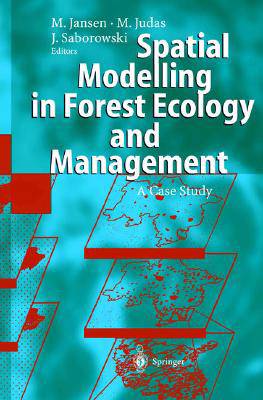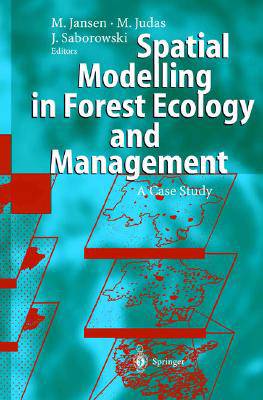
- Afhalen na 1 uur in een winkel met voorraad
- Gratis thuislevering in België vanaf € 30
- Ruim aanbod met 7 miljoen producten
- Afhalen na 1 uur in een winkel met voorraad
- Gratis thuislevering in België vanaf € 30
- Ruim aanbod met 7 miljoen producten
Zoeken
Spatial Modelling in Forest Ecology and Management
A Case Study
M Judas, J Saborowski, M Jansen
Hardcover | Engels
€ 183,45
+ 366 punten
Omschrijving
1 Abstract.- 2 Introduction.- 3 Study areas and basic data.- 3.1 Study areas.- 3.2 Basic data.- 3.2.1 Digital Elevation Models.- 3.2.2 Primary Forest Layers.- 3.2.2.1 Forest Inventory.- 3.2.2.2 Forest Site Evaluation.- 4 Statistical methods for regionalization of ecological state variables.- 4.1 Ordinary Kriging.- 4.2 Trend surface prediction.- 4.3 Kriging with trend.- 4.4 Crossvalidation.- 5 Spatial prediction of climate, soil, and macrofauna.- 5.1 Geomorphological and topoclimatic predictors derived from a DEM ..- Schulz, Mues, Jansen, Judas, Saborowski.- 5.1.1 Location dependent variables.- 5.1.2 First and second order derivatives of a DEM.- 5.1.3 Lee indices.- 5.1.4 Catchment size and related variables.- 5.1.5 Length of upward slopes.- 5.1.6 Relative exposure.- 5.1.7 Shape-Position Indices.- 5.1.8 Insolation indices.- 5.1.9 Quantification of landuse.- 5.2 Regionalization of climatic elements in Lower Saxony.- Mues, Jansen, Sloboda, Radler, Saborowski.- 5.2.1 Introduction.- 5.2.2 Sites and measurements.- 5.2.2.1 German Meteorological Service (DWD).- 5.2.2.2 Harz Mountains Waterworks (HWW).- 5.2.2.3 TRANSECT data.- 5.2.3 Localization of measurement stations.- 5.2.3.1 Accuracy of position.- 5.2.3.2 Shifting of the measurement stations.- 5.2.4 Models.- 5.2.4.1 Stratified models for Mountainous Region and Plains.- 5.2.4.2 Precipitation.- 5.2.4.2.1 Precipitation Plains.- 5.2.4.2.2 Precipitation Mountainous Region.- 5.2.4.3 Air temperature.- 5.2.4.3.1 Air temperature Plains.- 5.2.4.3.2 Air temperature Mountainous Region.- 5.2.5 Spatial representation of statistical models.- 5.2.6 Summary.- 5.3 Regionalization of soil chemical variables in the Harz mountains.- Jansen, Eberl, Beese.- 5.3.1 Introduction.- 5.3.2 Fundamentals of forest site evaluation: theory and models.- 5.3.3 Materials.- 5.3.4 Statistical analyses.- 5.3.5 Results and discussion.- 5.3.5.1 Geological substrates as a predictor of soil chemical variables.- 5.3.5.2 Nutrient index as a predictor of soil chemical variables.- 5.3.6 Multivariate models.- 5.3.7 Outlook.- 5.3.8 Summary.- 5.4 Regionalization of macrofauna populations.- Judas, Schaefer.- 5.4.1 Introduction.- 5.4.2 Area data.- 5.4.3 Point data.- 5.4.3.1 Sampling.- 5.4.3.2 Local habitat.- 5.4.4 Distribution patterns.- 5.4.4.1 General patterns.- 5.4.4.2 Species - habitat relations.- 5.4.4.3 Sampling stratification.- 5.4.5 Case study - distribution models for Pterostichus madidus.- 5.4.5.1 Initial Anova models.- 5.4.5.2 Multiple regression models.- 5.4.6 Multiple regression models for carabid beetle species.- 5.4.6.1 Optimization.- 5.4.6.2 Prediction.- 5.4.6.3 Habitat factors.- 5.4.6.4 Conclusions.- 5.4.7 Summary.- 6 Spatial models for site evaluation and forest planning.- 6.1 Forecast classification for the mapping of forest site properties.- Schulz, Judas.- 6.1.1 Principles of site mapping.- 6.1.2 Topoclimatic layers as support tools for mapping.- 6.1.2.1 Relative exposure in an unlimited surrounding.- 6.1.2.2 Insolation.- 6.1.2.3 Exposure to wind.- 6.1.3 Statistical approach to the modelling of relief units.- 6.1.3.1 Conceptual framework.- 6.1.3.2 Model quality indices.- 6.1.3.3 Implementation.- 6.1.3.4 Limitations to the modelling approach.- 6.1.3.5 Model selection.- 6.1.4 Statistical classification of moisture variants.- 6.1.4.1 Database.- 6.1.4.2 Modelling.- 6.1.4.3 Classification probabilities.- 6.1.5 Rule-based modelling of relief units.- 6.1.5.1 Shortcomings of the statistical approach.- 6.1.5.2 Implementation of classification rules.- 6.1.6 Conclusions.- 6.2 Modelling of forest growth areas in Lower Saxony.- Jansen, StUber, Wachter, Schulz, Schmidt, Saborowski, Mues, Eberl, Sloboda.- 6.2.1 Introduction.- 6.2.2 Analysis of current growth areas of Lower Saxony.- 6.2.3 Modelling of growth areas.- 6.2.3.1 Atlanticity-Continentality.- 6.2.3.2 Altitude belts.- 6.2.3.2.1 Influence of elevation and catchment size.- 6.2.3.2.2 Solar radiation.- 6.2.3.2.3 Cold air on level planes.- 6.2.3.2.4 Delimitation of altitu...
Specificaties
Betrokkenen
- Auteur(s):
- Uitgeverij:
Inhoud
- Aantal bladzijden:
- 248
- Taal:
- Engels
Eigenschappen
- Productcode (EAN):
- 9783540433576
- Verschijningsdatum:
- 1/08/2002
- Uitvoering:
- Hardcover
- Formaat:
- Genaaid
- Afmetingen:
- 167 mm x 241 mm
- Gewicht:
- 467 g

Alleen bij Standaard Boekhandel
+ 366 punten op je klantenkaart van Standaard Boekhandel
Beoordelingen
We publiceren alleen reviews die voldoen aan de voorwaarden voor reviews. Bekijk onze voorwaarden voor reviews.








